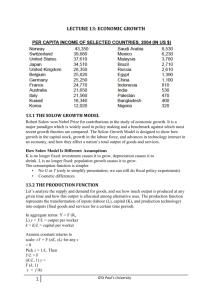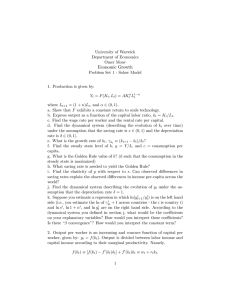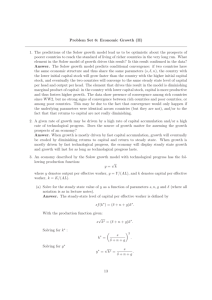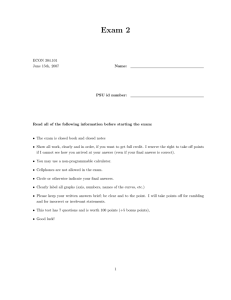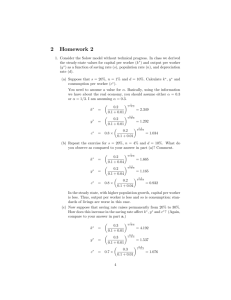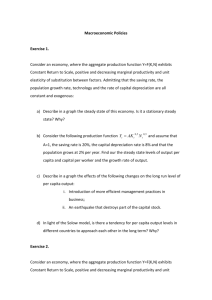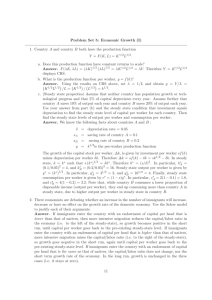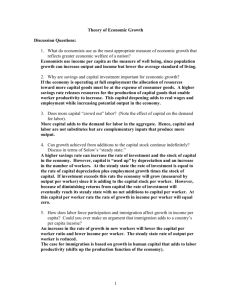BSc II Problem Set II Questions
advertisement
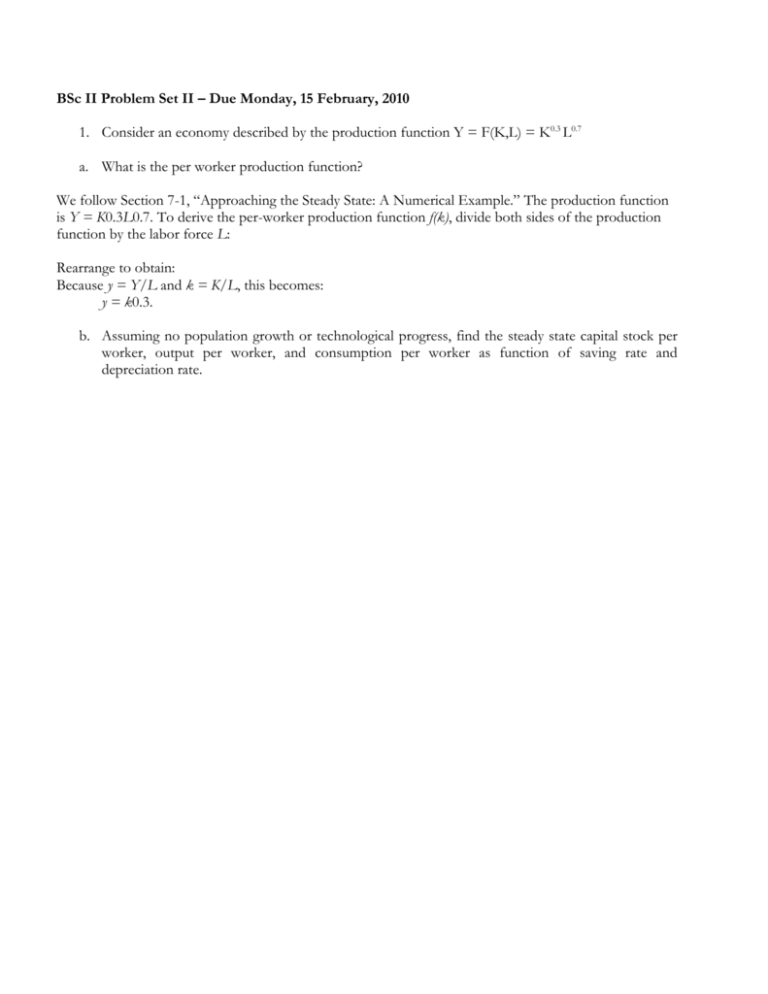
BSc II Problem Set II – Due Monday, 15 February, 2010 1. Consider an economy described by the production function Y = F(K,L) = K0.3 L0.7 a. What is the per worker production function? We follow Section 7-1, “Approaching the Steady State: A Numerical Example.” The production function is Y = K0.3L0.7. To derive the per-worker production function f(k), divide both sides of the production function by the labor force L: Rearrange to obtain: Because y = Y/L and k = K/L, this becomes: y = k0.3. b. Assuming no population growth or technological progress, find the steady state capital stock per worker, output per worker, and consumption per worker as function of saving rate and depreciation rate. c. Assume δ = 10% per year. Make a table showing steady-state capital per worker, output per worker and consumption per worker for saving rates of 0 percent, 10 percent, 20 percent, 30 percent and so on. What saving rate maximizes output per worker? What saving rate maximizes consumption per worker? d. Use calculus to find the marginal MPK. Add to your table the MPK – δ for each of the saving rates. What does your table show? 2. Consider how unemployment would affect the Solow growth model. Suppose that output is produced according to the production function Y = Kα[(1 – u)L1-α, where K is capital, L is labor force and ‘u’ is natural rate of unemployment. The national saving rate is ‘s’, the labor force grows at ‘n’ and capital depreciates at rate δ. a. Express output per worker (y = Y/L) as a function of capital per worker (k = K/L) and the natural rate of unemployment. Describe the steady state of this economy. b. Suppose a government policy reduces the ‘u’. Describe how this change affects output both immediately and over time. Is the steady state effect on output larger or smaller than the immediate effect? Explain. 3. Solow Growth Model. In the country of Akinback, an economy that can be described by the Solow Growth Model, income-per-worker is falling. Suddenly, a highly contagious disease kills one half of the younger workers in the labor force. The disease then quickly disappears. Other workers were not affected by the disease. Depreciation rates were not affected. However, in Akinback, younger workers have more job skills and higher saving rates than older workers. a. Based only on this information, use a Solow Growth Model diagram to accurately and clearly show the following. Also provide economic explanations. i. The economy’s initial economic situation, ii. The effect of the disease on the Akinback’s capital-to-labor ratio and income-per-worker, and iii. Akinback’s final steady state. Please note that break even investment rates such as depreciation, labor force growth or technology rates are not changing! Akinback’s initial steady state is at “A” with a capital-to-labor ratio of (K/N)A and income per-worker of (Y/N)A. If the economy were at this steady state, the economy’s long-run equilibrium growth rate would be the same as its labor force growth rate, i.e. ΔY/Y = ΔN/N. However, because we are told that Akinback’s income-per-worker level is falling we know that economic growth must be less than labor force growth, i.e., ΔY/Y < ΔN/N. This means that Akinback’s actual position is above its steady state at “A”. The capital-to-labor ratio is (K/N)0 > (K/N)A and income-per-worker is (Y/N)0 > (Y/N)A. Three things then happen. First, the disease kills one half of the younger workers. This immediately reduces the size of the labor force, N. As a result, the capital-to-labor (lowercase k) ratio rises to (K/N)1. This higher capital-to-labor ratio immediately increases income per- worker to (Y/N)1 Second, these deaths increase the average age of the work force. Because younger workers have more job skills, average productivity decreases. This is represented by a decrease in the level of technology, A, and shifts both the production function and the saving function down. As a result, while still at a capital-tolabor ratio of (K/N)1, income-per-worker would fall from (Y/N)1 to (Y/N)2. [Depending on the size of the productivity change, (Y/N)2 could be either greater than, equal to, or less than (Y/N)A.] Third, because these deaths increase the average age of the work force and younger workers have higher saving rates than older workers, the economy’s average saving rate, s, decreases. This shifts the saving function down again. The result of these last two factors is to create a new, lower steady state at “B”. 4. Assume that China grows at a faster rate than US. Is China farther away from its Golden rule level of savings and consumption? Explain if the income disparity across these two regions would disappear over time? If China is growing at a higher rate then it is farther away from its Golden rule steady state level. If it continues to growth at this rate, given savings rate is higher than that of US and population growth rate is not higher than US, then the disparity will disappear according to Solow growth model. THE IDEA OF CONDITIONAL AND ABSOLUTE CONVERGENCE SHOULD BE DISCUSSED. 5. Suppose we know that workers tend to receive 70% of all the income earned in Germany, that the German depreciation rate is 10%, and that there is no population growth or technological progress. Suppose we CANNOT assume the production function in Germany takes the convenient Cobb-Douglas form ( Do not assume Y = AKαL1-α). But we can assume that whatever the production function is, it has constant returns to scale, that the only two factors of production are capital and labor, that markets are competitive, and that firms maximize profits. Using just this information, compute what saving rate Germany should try to have, if it wants to enjoy the maximum amount of consumption per person in steady state (that is, to achieve the golden rule). [You might find this one difficult. Hint: Make use of Euler’s theorem from chapter 3, along with the key Solow model equations from chapter 7.] w = 0.7y R = y – 0.7 y = 0.3y, which is also equal to MPK Consumption maximized if MPK = depreciation * k 0.3y = 0.1k y = k/3 In steady state: sf(k) = Depreciation * k s (k/3) = 0.1*k s = 30% 6. Suppose that permanent income is calculated as the average of income over the past 5 years; that is YP= 1/5(Y + Y-1 + Y-2 + Y-3 + Y-4) (P1) Suppose further that consumption is given by C = .9YP a) If you have earned $20,000 per year for the past 10 years, what is your permanent income? YP = 1/5*(20000*5) = 20,000 b) Suppose the next year (period t + 1) you earn $30,000. What is your new YP? YP = 1/5 * (20000*4 + 30000) = 22,000 c) What is your consumption this year and next year? Ct = 0.9* 20000 = 18000, Ct+1 = 0.9*22000 = 19800 d) What is your short-run marginal propensity to consume? Long-run MPC? Taking the answer of part ‘c’ MPC = 1800 / 2000 = 0.9 MPC stays constant, so it should be 0.9 e) Assuming you continue to earn $30,000 starting in period t + 1, graph the value of your permanent income in each period, using equation (P1). Income 30000 20000 time 7. Suppose that 70 percent of a country’s population, as a consequence of liquidity constraints, behaves in accordance with the traditional model of consumption and thus consumes, every period, a given fraction of its disposable income. The other 30 percent of the population behaves in accordance with the LC-PIH. a) If the MPC in the traditional model is .8 and disposable income changes by $10 million (you may assume that this change is due entirely to a change in transitory income), by how much will consumption change? Change in consumption (0.7) * (0.8) * (10) + (0.3)*(10)*(1/60) = 5.65 B, assuming that working life is 60 years! OR Change in consumption = (0.7) * (0.8) * (10) = 5.6 B b) What if 70 percent of the population behaves in accordance with the LC-PIH and 30 percent behaves in accordance with the traditional model? Change in consumption (0.7) * (10)*(1/60) + (0.3) * (0.8) *(10) = 2.52 B, assuming that working life is 60 years! OR Change in consumption = (0.3) * (0.8) * (10) = 2.4 B c) What if 100 percent of the population behaves in accordance with the LC-PIH? All of that could be saved OR assuming that working life is 60 years, change in consumption = (10)*1/60 = 0.17 B
